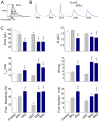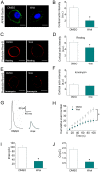Src kinases regulate de novo actin polymerization during exocytosis in neuroendocrine chromaffin cells
- PMID: 24901433
- PMCID: PMC4047038
- DOI: 10.1371/journal.pone.0099001
Src kinases regulate de novo actin polymerization during exocytosis in neuroendocrine chromaffin cells
Abstract
The cortical actin network is dynamically rearranged during secretory processes. Nevertheless, it is unclear how de novo actin polymerization and the disruption of the preexisting actin network control transmitter release. Here we show that in bovine adrenal chromaffin cells, both formation of new actin filaments and disruption of the preexisting cortical actin network are induced by Ca2+ concentrations that trigger exocytosis. These two processes appear to regulate different stages of exocytosis; whereas the inhibition of actin polymerization with the N-WASP inhibitor wiskostatin restricts fusion pore expansion, thus limiting the release of transmitters, the disruption of the cortical actin network with cytochalasin D increases the amount of transmitter released per event. Further, the Src kinase inhibitor PP2, and cSrc SH2 and SH3 domains also suppress Ca2+-dependent actin polymerization, and slow down fusion pore expansion without disturbing the cortical F-actin organization. Finally, the isolated SH3 domain of c-Src prevents both the disruption of the actin network and the increase in the quantal release induced by cytochalasin D. These findings support a model where a rise in the cytosolic Ca2+ triggers actin polymerization through a mechanism that involves Src kinases. The newly formed actin filaments would speed up the expansion of the initial fusion pore, whereas the preexisting actin network might control a different step of the exocytosis process.
Conflict of interest statement
Figures










Similar articles
-
The F-Actin Binding Protein Cortactin Regulates the Dynamics of the Exocytotic Fusion Pore through its SH3 Domain.Front Cell Neurosci. 2017 May 4;11:130. doi: 10.3389/fncel.2017.00130. eCollection 2017. Front Cell Neurosci. 2017. PMID: 28522963 Free PMC article.
-
Dynamin-2 regulates fusion pore expansion and quantal release through a mechanism that involves actin dynamics in neuroendocrine chromaffin cells.PLoS One. 2013 Aug 5;8(8):e70638. doi: 10.1371/journal.pone.0070638. Print 2013. PLoS One. 2013. PMID: 23940613 Free PMC article.
-
αII-spectrin controls calcium-regulated exocytosis in neuroendocrine chromaffin cells through neuronal Wiskott-Aldrich Syndrome protein interaction.IUBMB Life. 2020 Apr;72(4):544-552. doi: 10.1002/iub.2217. Epub 2019 Dec 20. IUBMB Life. 2020. PMID: 31859439
-
[Bacterial toxins: useful for studying G-proteins implicated in the mechanism of exocytosis in neuroendocrine cells].J Soc Biol. 1999;193(6):451-6. J Soc Biol. 1999. PMID: 10783703 Review. French.
-
Two pathways control chromaffin cell cortical F-actin dynamics during exocytosis.Biochimie. 2000 Apr;82(4):339-52. doi: 10.1016/s0300-9084(00)00193-0. Biochimie. 2000. PMID: 10865122 Review.
Cited by
-
Anesthetic Propofol Promotes Tumor Metastasis in Lungs via GABAA R-Dependent TRIM21 Modulation of Src Expression.Adv Sci (Weinh). 2021 Sep;8(18):e2102079. doi: 10.1002/advs.202102079. Epub 2021 Jul 15. Adv Sci (Weinh). 2021. PMID: 34263559 Free PMC article.
-
How does the stimulus define exocytosis in adrenal chromaffin cells?Pflugers Arch. 2018 Jan;470(1):155-167. doi: 10.1007/s00424-017-2052-5. Epub 2017 Aug 29. Pflugers Arch. 2018. PMID: 28852855 Review.
-
Wasl is crucial to maintain microglial core activities during glioblastoma initiation stages.Glia. 2022 Jun;70(6):1027-1051. doi: 10.1002/glia.24154. Epub 2022 Feb 22. Glia. 2022. PMID: 35194846 Free PMC article.
-
Defects in G-Actin Incorporation into Filaments in Myoblasts Derived from Dysferlinopathy Patients Are Restored by Dysferlin C2 Domains.Int J Mol Sci. 2019 Dec 19;21(1):37. doi: 10.3390/ijms21010037. Int J Mol Sci. 2019. PMID: 31861684 Free PMC article.
-
The F-Actin Binding Protein Cortactin Regulates the Dynamics of the Exocytotic Fusion Pore through its SH3 Domain.Front Cell Neurosci. 2017 May 4;11:130. doi: 10.3389/fncel.2017.00130. eCollection 2017. Front Cell Neurosci. 2017. PMID: 28522963 Free PMC article.
References
-
- Trifaró JM, Rosé SD, Marcu MG (2000) Scinderin, a Ca2+-dependent actin filament severing protein that controls cortical actin network dynamics during secretion. Neurochem Res 25: 133–144. - PubMed
-
- Malacombe M, Bader MF, Gasman S (2006) Exocytosis in neuroendocrine cells: new tasks for actin. Biochim Biophys Acta 1763: 1175–1183. - PubMed
-
- Giner D, Neco P, Francés Mdel M, López I, Viniegra S, et al. (2005) Real-time dynamics of the F-actin cytoskeleton during secretion from chromaffin cells. J Cell Sci 118: 2871–2880. - PubMed
Publication types
MeSH terms
Substances
LinkOut - more resources
Full Text Sources
Other Literature Sources
Miscellaneous

